
The capybara or greater capybara is a giant cavy rodent native to South America. It is the largest living rodent and a member of the genus Hydrochoerus. The only other extant member is the lesser capybara. Its close relatives include guinea pigs and rock cavies, and it is more distantly related to the agouti, the chinchilla, and the nutria. The capybara inhabits savannas and dense forests, and lives near bodies of water. It is a highly social species and can be found in groups as large as 100 individuals, but usually live in groups of 10–20 individuals. The capybara is hunted for its meat and hide and also for grease from its thick fatty skin. It is not considered a threatened species.
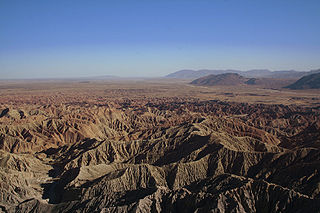
Anza-Borrego Desert State Park is a California State Park located within the Colorado Desert of southern California, United States. The park takes its name from 18th century Spanish explorer Juan Bautista de Anza and borrego, a Spanish word for sheep. With 585,930 acres (237,120 ha) that includes one-fifth of San Diego County, it is the largest state park in California and the second biggest park nationally.
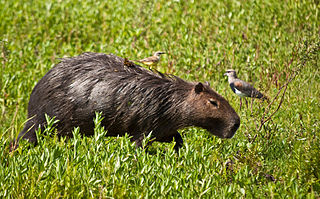
The genus Hydrochoerus contains two living and three extinct species of rodents from South America, the Caribbean island of Grenada, California and Panama. Capybaras are the largest living rodents in the world. The genus name is derived from the Greek ὕδωρ 'water' plus χοίρος 'pig'.
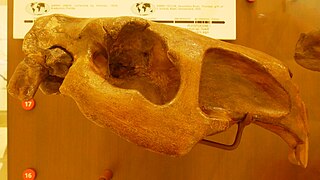
Neochoerus pinckneyi was a North American species of capybara. While capybaras originated in South America, formation of the Isthmus of Panama three million years ago allowed some of them to migrate north as part of the Great American Interchange. Capybaras and porcupines are the only caviomorph rodents that reached temperate North America during this exchange. At 90–113 kilograms (198–249 lb), 40% larger than the living capybara, N. pinckneyi is one of the largest rodent species ever discovered, surpassed only by Josephoartigasia monesi, several species of Phoberomys, and possibly the Pleistocene giant beaver. Remains have been found in southern North America, from Arizona to Florida to South Carolina, and throughout Central America.

Hydrochoerinae is a subfamily of Caviidae, consisting of two living genera, Hydrochoerus, the capybaras, and Kerodon, the rock cavies. In addition, a number of extinct genera related to capybaras should also be placed in this subfamily. The taxonomy of Hydrochoerinae is confused because, until 2005, living capybaras and their extinct relatives were placed in their own family, Hydrochoeridae. Recent molecular phylogenetic studies recognize a close relationship between Hydrochoerus and Kerodon, supporting placement of both genera in a subfamily of Caviidae. Paleontological classifications have yet to incorporate this new taxonomy, and continue to use Hydrochoeridae for all capybaras, while using Hydrochoerinae for the living genus and its closest fossil relatives such as Neochoerus. The taxonomy of fossil hydrochoerines is also in a state of flux. In recent years, the diversity of fossil hydrochoerines has been substantially reduced. This is largely due to the recognition that capybara molar teeth show strong variation in shape over the life of an individual. In one instance, material once referred to four genera and seven species on the basis of differences in molar shape is now thought to represent differently aged individuals of a single species, Cardiatherium paranense.

Glyptotherium is a genus of glyptodont in the family Chlamyphoridae that lived from the Early Pliocene, about 4.9 million years ago, to the Early Holocene, around 7,000 years ago. It had a wide distribution, living in the United States, Mexico, Guatemala, Costa Rica, Honduras, El Salvador, Panama, Venezuela, and Brazil. The genus was first described in 1903 by American paleontologist Henry Fairfield Osborn with the type species being, G. texanum, based on fossils that had been found in the Pliocene Blancan Beds in Llano Estacado, Texas, USA. Glyptotherium fossils have since been unearthed from many more fossil sites, from Florida to Colombia. Another species, G. cylindricum, was named in 1912 by fossil hunter Barnum Brown on the basis of a partial skeleton that had been unearthed from the Pleistocene deposits in Jalisco, Mexico. The two species differ in several aspects, including age, with G. texanum being from the older Early Pliocene to Early Pleistocene strata, whereas G. cylindricum is exclusive to the Late Pleistocene and Early Holocene.
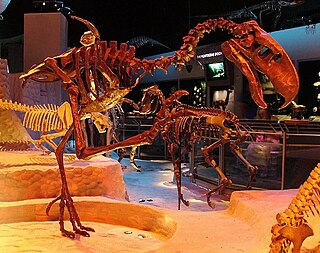
Titanis is a genus of phorusrhacid, an extinct family of large, predatory birds, in the order Cariamiformes that inhabited the United States during the Pliocene and earliest Pleistocene. The first fossils were unearthed by amateur archaeologists Benjamin Waller and Robert Allen from the Santa Fe River in Florida and were named Titanis walleri by ornithologist Pierce Brodkorb in 1963, the species name honoring Waller. The holotype material is fragmentary, consisting of only an incomplete right tarsometatarsus and phalanx, but comes from one of the largest phorusrhacid individuals known. In the years following the description, many more isolated elements have been unearthed from sites from other areas of Florida, Texas, and California. It was classified in the subfamily Phorusrhacinae, which includes some of the last and largest phorusrhacids like Devincenzia and Kelenken.

Tremarctos floridanus, occasionally called the Florida spectacled bear, Florida cave bear, or rarely Florida short-faced bear, is an extinct species of bear in the family Ursidae, subfamily Tremarctinae. T. floridanus was widespread in the Southeastern United States during the Rancholabrean epoch, with scattered reports of fossils from other parts of North America and from earlier epochs.
The Rancholabrean North American Land Mammal Age on the geologic timescale is the North American faunal stage according to the North American Land Mammal Ages chronology (NALMA), typically set from less than 240,000 years to 11,000 years BP, a period of 0.229 million years. Named after the famed Rancho La Brea fossil site in Los Angeles, California, the Rancholabrean is characterized by the presence of the genus Bison in a Pleistocene context, often in association with other extinct Pleistocene forms such as Mammuthus. The age is usually considered to overlap the late Middle Pleistocene and Late Pleistocene epochs. The Rancholabrean is preceded by the Irvingtonian NALMA stage, and it is succeeded by the Santarosean age.

Canis edwardii, also known as Edward's wolf, is an extinct species of wolf in the genus Canis which was endemic to North America three million years ago from the Late Blancan stage of the Pliocene epoch and was extinct by the end of the Irvingtonian stage of the Pleistocene epoch.
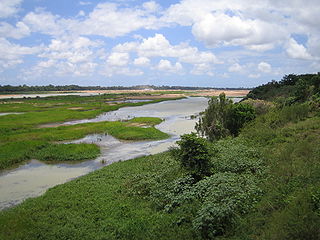
The Bluff Downs fossil site is a paleontological site of Pliocene age in northern Queensland, Australia. It is one of the most significant fossil sites of Pliocene age in Australia due to its unique fauna and specific dating. The fossil site lies on the banks of the Allingham Creek on the pastoral property of Bluff Downs Station, northwest of Charters Towers on the Cape York Peninsula

Orcinus citoniensis is an extinct species of killer whale identified in the Late Pliocene of Italy and the Early Pleistocene of England. It was smaller than the modern killer whale, 4 m (13 ft) versus 7 to 10 m, and had around 8 more teeth in its jaw. It may have resembled the modern killer whale in appearance, and could represent a transitional species between the modern killer whale and other dolphins. O. citoniensis could have hunted fish and squid in pods, and coexisted with other large predators of the time such as the orcinine Hemisyntrachelus and the extinct shark Otodus megalodon.
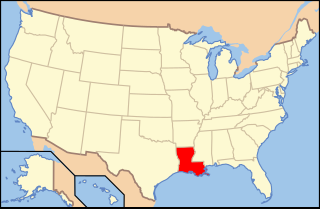
Paleontology in Louisiana refers to paleontological research occurring within or conducted by people from the U.S. state of Louisiana. Outcrops of fossil-bearing sediments and sedimentary rocks within Louisiana are quite rare. In part, this is because Louisiana’s semi-humid climate results in the rapid weathering and erosion of any exposures and the growth of thick vegetation that conceal any fossil-bearing strata. In addition, Holocene alluvial sediments left behind by rivers like the Mississippi, Red, and Ouachita, as well as marsh deposits, cover about 55% of Louisiana and deeply bury local fossiliferous strata.
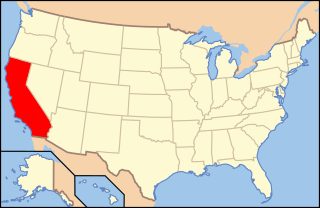
Paleontology in California refers to paleontologist research occurring within or conducted by people from the U.S. state of California. California contains rocks of almost every age from the Precambrian to the Recent. Precambrian fossils are present but rare in California.

The pristine mustached bat is an extinct Late Quaternary species of bat in the endemic Neotropical family Mormoopidae. It was distributed in Cuba and possibly Florida.
The Camp Rice Formation is a geologic formation in west Texas and southern New Mexico. It preserves fossils of the Pliocene-Pleistocene. These include the distinctive Tonuco Mountain Local Fauna.
Neochoerus aesopi was a relatively large rodent species native to North America until their extinction about 12,000 years ago, being closely related to modern capybaras. It was part of the subfamily Hydrochoerinae. Fossils of it have been found in U.S. states such as Florida and South Carolina. The species was originally outlined in 1853, it weighed about 80 kg similar in size to the modern day capybara.
Hydrochoerus gaylordi is an extinct species of capybara that lived in Grenada during the Late Pliocene to Early Pleistocene. This species was found in 1991 by Ronald Singer and his colleagues based on a maxilla bearing 3 molars, but it was not named until 2000. It may be invalid and a synonym of the extant greater capybara.

Capromeryx was a genus of dwarf pronghorns (Antilocapridae) that originated in North America during the Pliocene about 5 million years ago. The closest living relative and only surviving member of the family is the North American pronghorn.

The San Gregorio Formation is a lithostratigraphic unit dating back to the Pliocene to Pleistocene of Venezuela. The formation is split into three members, the older Vergel Member, the Cocuiza Member (Pleistocene) and the Río Seco Member. During this time the region is thought to have been covered by a mixed environment of open grassland and forested areas surrounding a permanent freshwater system. The diverse fauna of the San Gregorio Formation, including a variety of freshwater fish, crocodilians, turtles and snakes, also includes many mammals interpreted to have been part of the first major wave of the Great American Interchange in addition to native clades such as glyptodonts, ground sloths and caviomorph rodents.

















